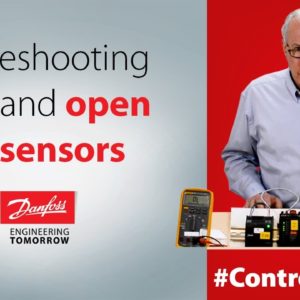[music] [KEITH] Hi, I'm Keith with Danfoss food retail
controls and today's video will be on troubleshooting temperature sensors in a
real-time environment. In this video we're going to do some troubleshooting
of a temp sensor. So, this is going to be a basic layout where we will have the
temp sensor that is in some ice water, that'll get us very close to a medium
temp application, we'll have our wire that is going to be
running from the case back to the control, and then here we have our i/o
boards and lastly we have our system manager.
So as a package we can very
easily troubleshoot to find out the status of our sensor. So as you can see
on the chart, we work in a range from -58, which is 800 ohms, up to 95
degrees, which is 1,136 ohms. The sensor is a PT1000,
so 1,000 ohms is equal to 32 degrees and if you wanted to reference a
low temp application of close to -10, you would be about 910 ohms. So now
we're going to look at the different scenarios for a temp sensor.
As we have
it right now, in normal operating conditions, we can see on the display
33.4 degrees, but what is it going to show us if we have a
short. Well, I'll take these two leads and I'll hold them together and we notice it
goes to a -148. So now we have that condition, the other one, other than the
normal, will be an open. I remove one of the leads, we're going to see that it is
going to 392.
So our our outside extremes plus our normal condition are typically
what we need to be dealing with. The other thing that we can always do is
take our leads to our meter and if we go on either one of the, or across the, two
leads we're going to see our ohm reading being 1000 ohms. That's exactly what
we're expecting it to be which is an indication that we are right on money when it a medium temp case and we are in a 32
degree environment.

So now we're going to start troubleshooting to find out why we
have a short. So we've come into the store, we see that we have a -148 on
the display, that's telling us that somewhere from the system manager down
to that case, we have a shorted condition. The best way to troubleshoot is to
isolate your problem and/or possibly divide this troubleshooting into two
pieces. Well, if we are in the compressor room working, we have a system manager, we
have the i/o all local to us, it is very simple to go up to my i/o, to disconnect
the lead going down to my case sensor and notice that it went to 392, which
means we have an open. So from my i/o board, I can tell a short and an open,
that means that the operation of my i/o and my system manager are correct,
they're good.
That means also that the problem has to exist either in the
wiring or in the sensor itself. We're now down on the floor and we're going to
further evaluate or troubleshoot this problem. So we're not going to go to
where the case, the sensor is inside the case we're going to go to where the
wires are connected to the cable returning to the i/o, or back up to the
motor room. I will go down here and I will remove at least one of the two
wires and I'm going to take my meter and I'm going to put it across and I'm
looking for it to show me somewhere very close to 1,000 ohms because I know
from that chart that 1,000 ohms has me very close to 32 degrees. There's an
excellent indicator that the sensor itself is good. We will work with the
assumption, at least right at this moment, that the cables the problem. How could I
best evaluate that? I will take the two cable leads, I will put my meter on volts
DC and I'm going to read back and see what I have coming from my i/o.
Notice I
have a short. So now my troubleshooting was very simplified that I verified all
the i/o was correct, I verified the sensor was correct and I also verified that the
cable is shorted. So to recap on our troubleshooting, we first validated where the problem was located so we went back to the system manager, into the
i/o, we did a short and open and we validated or verified that the problem
was not there, we went down to the sensor, we put our meter on, ohmmeter,
we verified that the ohm reading was correct and then we read back through
the cable and we found that it was shorted. The cable has now been replaced,
everything has been rewired back to the norm and if I look on the display I'm
reading 33 degrees, so everything is back to good. For more information on this
topic, see the description below and for more videos like this visit our YouTube channel Danfoss Cool US and thank you for watching.
[music[.

